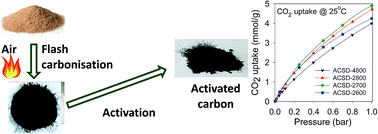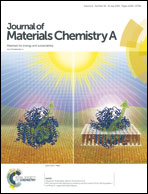A simple flash carbonization route for conversion of biomass to porous carbons with high CO2 storage capacity†
Abstract
This work offers a new, and simpler, method for the carbonisation of biomass that involves flash carbonisation of biomass at relatively low temperature (≤400 °C). We successfully converted the biomass precursor (eucalyptus sawdust) to carbonaceous matter via flash heating for a short period of time (5–10 minutes) under a flow of air. On activation, the flash carbonized carbon offers high yields of activated carbons with higher microporosity compared to sawdust derived activated carbons prepared via hydrothermal carbonization or conventional pyrolysis. Depending on the level of activation, the flash carbonized sawdust-derived activated carbons retain some ‘woody’ morphology preserved from the sawdust. The porosity of the carbons can be tailored towards being predominantly microporous, which generates adsorbents that exhibit very attractive CO2 uptake (up to 5.0 mmol g−1) at 1 bar and 25 °C. Moreover, depending on the level of activation, it is possible to tailor the porosity of the carbons such that they simultaneously exhibit high post-combustion (<1 bar) and pre-combustion (20 bar) CO2 capture capability. The carbons exhibit exceptional performance for low pressure swing adsorption (PSA) with a working capacity of up to 8.3 mmol g−1 for a pure CO2 stream (6 to 1 bar) and up to 5.6 mmol g−1 for flue gas (1.2 to 0.2 bar), while the working capacity for vacuum swing adsorption (VSA) reaches 5.3 mmol g−1 under pure CO2 (1.5 to 0.05 bar), and 2.1 mmol g−1 for flue gas (0.3 to 0.01 bar) conditions.



 Please wait while we load your content...
Please wait while we load your content...